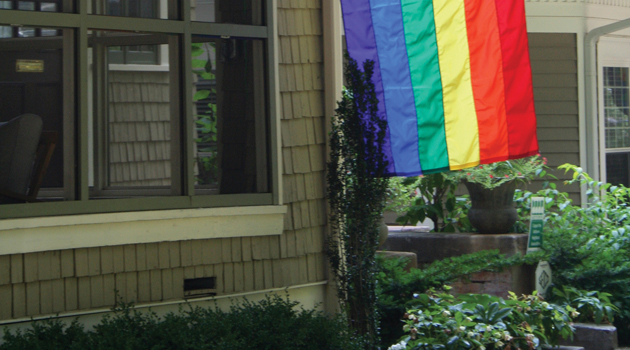
Houston’s Hot Real Estate
Realtors reveal their favorite up-and-coming neighborhoods.
by Karen Derr
See also: Emerging Real-Estate Trends in Top LGBT Cities

In light of Houston’s low inventory of homes for sale and rising home prices, especially in inner-loop neighborhoods like the Heights and Montrose, Realtors are turning to lesser-known areas to satisfy their buyers. The Houston Association of Realtors reported in March that the local market was experiencing its lowest-ever inventory of homes for sale. With just 2.6 months of inventory, Houston is definitely a seller’s market. Quality homes in tried-and-true neighborhoods get multiple offers, sometimes within hours of listing on the Multiple Listing Service. It is not uncommon for the winning bid to come in well above list price, pricing some buyers out of the market. Buyers are often asked to commit in advance to pay more than the property may appraise for and make up the difference with an additional down payment.
This has sent Realtors and investors scrambling to target the neighborhoods most likely to be the hot-spots of tomorrow. One such area is just east of downtown Houston—or EaDo, as it has been called in recent years—as well as the historic neighborhood of Eastwood. When polling Realtors specializing in the inner loop, EaDo came up again and again as Houston’s next hot neighborhood. With new construction in EaDo and the lovely historic homes in Eastwood, the area has something for everyone. Mike Copenhaver with Remax Metro says, “I have been showing east of Downtown, or EaDo and Eastwood, quite a bit. The location is close to downtown, and with the new Harrisburg light-rail line about to open, development of restaurants and shopping can’t be too far behind.”
Jeremy Fain with Greenwood King, himself an EaDo resident, agrees. “I’ve had a great time introducing people to East Downtown,” he says. “Most of the new construction is three- or four-story townhomes which include high-end finishes, appliances, and detailing. Some properties, like mine, even include a rooftop terrace overlooking the flawless downtown skyline, which is perfect for taking in late-night fireworks shows erupting from Minute Maid Park.”
Fain believes property values will continue to rise over the next few years due to the BBVA Compass Stadium, the completion of light rail, and the recently opened Watershed Market, which provides fresh locally grown produce and goods along a promenade of 200 newly installed trees. He confides, “I encounter people purchasing these properties solely as investments, before the word gets out about this rapidly growing area and prices start to skyrocket.”
Along with EaDo, Debbie Levine says her clients are also opting for Sawyer Heights and Cottage Grove. These neighborhoods, which are adjacent to the Heights, offer mostly new construction on smaller lots. The top producer with Greenwood King says, “They’re affordable and still in close proximity to all of the amenities that the inner loop has to offer. In addition, many buyers feel like they are getting in at a good entry point. They are banking that these areas will see the growth and appreciation that the Heights and Montrose have seen over the years.”
For newer construction, Andy Weber with John Daugherty Realtors likes Shady Acres and the neighborhoods west of the Heights. He says they appeal to buyers who like the Heights. “These areas also offer eateries and bars that are similar to Montrose and the Heights,” explains Weber. The Shady Acres area is home to the popular Cedar Creek restaurant, Hub Cap, Crisp, The Corkscrew, and many more.
For more traditional homes, Tim Anthony with Anthony Upton Properties also heads west of the Heights to Timbergrove and just north of the loop to Garden Oaks. A longtime Montrose resident himself, he says, “With the low inventory and increasing list prices in Montrose and Heights, I am finding that my buyers are pleased when I begin to show them listings in Timbergrove and Garden Oaks.” With original homes from the 1930s to 1960s, these neighborhoods appeal to buyers looking for mature landscaping and lots of trees. Prices are only slightly below prices in the Heights and Montrose, but buyers generally get more square footage and a larger lot for their money.
If 1920s and ’30s bungalows are your style, Realtor Alan Frieze recommends Lindale Park on the near-north side of downtown. He says, “The neighborhood continues to strengthen, and the bungalows offer the same character. Many are yet to be updated, so my buyers that are looking for a project find it interesting.” Lindale Park is a good choice, much like Eastwood, for historic charm, proximity to new rail lines, and an active homeowners association.
Of course, for mid-century modern homes nicely updated or ready to be transformed, Oak Forest is a popular community. But with new homebuilders snapping them up for their spacious lots, competition is fierce. Shepherd Park Plaza is a good alternative. The neighborhood offers lovely updated homes on 8,000 sq. ft. or larger lots priced in the $300,0000s. An 8,000 sq. ft. lot is a rarity in the Heights or Montrose, and Shepherd Park Plaza is only five minutes outside the loop.
If you’re working in the Galleria or driving to the I-10 Energy Corridor, solid neighborhoods with mid-century-era homes and new construction options can be found by going just a little farther west. Pat Walker reports she has sold four homes recently in Mangum Manor. The longtime Oak Forest-area Realtor with Keller Williams Metropolitan describes it as “a small, deed-restricted neighborhood, surrounded by Oak Forest. The prices are quickly rising. There are four new constructions going on right now on Poinciana Drive. The other ‘best-kept-secret neighborhood,’ I think, is Shepherd Park Terrace. It was developed by the same builder as Shepherd Park Plaza, but is just north of Pinemont. A buyer can get a lot of house for the money.” List prices are generally in the $200,000s. Both of these neighborhoods are about 10 minutes away from Heights shopping and dining, but nearby Oak Forest has its own restaurant scene with loyal fans.
So if your Realtor has convinced you to look outside the loop to get more value, you won’t have to go far. Many real-estate professionals are reintroducing would-be inner-loop buyers to Spring Branch. Alan Frieze, who is also with Keller Williams Metropolitan, says his buyers can justify buying a more expensive home than they had originally planned if they are able to get into desirable Spring Branch I.S.D., which serves close-in neighborhoods like Spring Valley. Prices for homes in Spring Valley and the surrounding new-construction developments are on par with the Heights and Montrose, but you may miss the urban vibe. Frieze explains the trade-off in choosing a neighborhood with desirable public schools: “These are families faced with decisions on schools, and they figure that they would rather buy more home while rates are low, instead of paying for private school down the road.”
Raymond Garcia with the Reyna Realty Group agrees that Spring Branch is a great close-in choice for buyers priced out of the Heights and Montrose. He says, “With an estimated 48 homes sold since the beginning of 2014, people looking for a home with character, generous square footage, and a good-size yard are looking no further than Spring Branch.”
It’s apparent that Realtors and buyers are open to considering up-and-coming neighborhoods as alternatives to high-priced real estate inside the loop. However, one should keep in mind that as prices show no signs of coming down in the Heights and Montrose, today’s prices just might look like steals later this year.
Karen Derr is a Houston-area Realtor and the founder of Karen Derr Realty, now Boulevard Realty. She writes and speaks about home and small-business topics. She can be reached at [email protected].
_________________________________

Emerging Real-Estate Trends in Top LGBT Cities
by Jeff Hammerberg
The Urban Land Institute and PricewaterhouseCoopers recently co-published the 35th annual edition of Emerging Trends in Real Estate. This publication provides an outlook on annual market trends that is widely read by real-estate professionals. The analysis for 2014 includes information about the top markets in the United States, thus provoking the question, “Of these top markets, which ones are LGBT-friendly?” The answer (not that surprising) is that all of the top markets—especially those with revitalized downtowns—were also very LGBT-friendly, including two of the most gay-friendly metropolises in the world—San Francisco and New York.
The number-one top market on this publication’s list is San Francisco, which is top ranked for a second year in a row. San Francisco earned this position because it is rich with potential for home building and an easy place to make money selling and buying real estate. It is also a city that is open to new development. San Francisco is a city where there is a lot of capital available for new projects and there is little “financial prejudice” against gays. In 2014, this number-one LGBT-friendly place in America is predicted to thrive as well as it did in 2013, partially because the economy is supposed to experience an increased employment rate of 2 percent this year and an increase in individual personal income of 5.5 percent. This helps residents offset the high cost of living downtown. San Francisco is also unusual because it does not have a burnt-out city core.
Thanks partly to a caring and wealthy LGBT influence, the downtown areas of San Francisco are revitalized to the extent that 36 percent of new residents to the city are moving into the metro downtown. Emerging Real Estate Trends recommends San Francisco as being the number-one “solid buy” for investors in the United States, with great neighborhoods, beautiful hotels, and gorgeous parks.
The second top market on the list is Houston. Houston has a huge arts community that is very friendly to LGBT individuals and also young people. Houston is particularly suited for investment in new buildings. It is also described as a city with long-term above-average economic growth with expansion predicted in the health, energy, and distribution industries.
San Jose, California, was third on the list with a profile for growth very similar to its neighboring big city of San Francisco. Jobs in the area of technology are likely to expand in this well-known center for technical innovation.
New York was fourth on the list and rates high when it comes to business and professional employment growth, surpassing many other large metro areas in terms of having a highly productive, well-paid and also well-educated workforce. Of course, New York is well known for being an LGBT-friendly haven. Emerging Trends predicts that in 2014 the apartment and hotel markets will be very hot in the Big Apple.
Dallas/Fort Worth, Seattle, Austin, Miami, and Boston were next on Emerging Trends’ list of top markets in the United States, and it is also interesting to note that all of these cities—but especially Seattle, Austin, and Miami—also rank as excellent places for gays and lesbians to settle down in as well.
Author Jeff Hammerberg is the founding CEO of GayRealEstate.com. For more information visit gayrealestate.com.











Comments